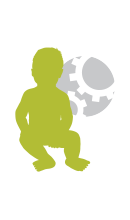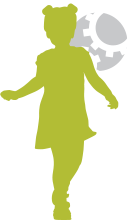Component 1: Logic and Reasoning
Standard 1.a: Children apply strategies and draw upon past knowledge and experiences to meet goals and solve problems.
By the following age ranges, children typically, for example:
- Explore objects and materials in different ways (e.g., mouthing, reaching for, or hitting, banging, and squeezing them)
- Bang a block (or other object) on the floor repeatedly to hear the sound that it makes
- Combine learning schemes to learn more about an object (e.g., mouthing and then shaking a rattle)
- Demonstrate an understanding of simple cause and-effect relationships (e.g., looking toward the sky when they hear an airplane)

- Explore small openings and look for items to put in the openings, including their fingers
- Solve simple problems independently (e.g., by climbing to retrieve an out of-reach object)
- Demonstrate recognition of cause-and-effect relationships (e.g., pushing on a toy truck and watching it roll away)
- Use visual comparisons to compare quantities (e.g., which pile of crackers has more)
- Stack and then knock down “towers” and then stack them up again

- Explore the properties of objects by grabbing, pushing, pulling, turning over, and throwing them
- Make simple decisions, take action, and observe the effect of their actions on others (e.g., pushing a toy truck toward an adult, watching it hit the adult, and observing how the adult reacts)
- Treat objects differently as they begin to understand similarity and difference (e.g., squeezing stuffed animals and throwing balls)
- Separate objects by a single feature (e.g., color
- Match simple geometric forms (e.g., circle, square, triangle) that have the same size and orientation
- Develop learning schemes related to people and actions (e.g., saying “goodbye” and then leaving, or asking for music and then dancing to it)

- Make plans before attempting to solve some simple problems
- Explore cause-and effect relationships by intentionally repeating an action and observing the reaction (e.g., rolling a car down a ramp repeatedly and observing the distance the car traveled)
- Engage in pretend play sequences (e.g. playing “kickball” which requires kicking a ball, running, and then stopping at a base, not necessarily in order)

- Use previous experiences to make plans before attempting to solve some problems (e.g., using a wagon to gather toys into one spot rather than trying to carry them all by hand)
- Solve simple problems without trying every possibility (e.g., putting big blocks at the base of a tower and smaller blocks on top to make a tower that doesn’t topple)
- Explore cause-and-effect relationships by intentionally varying the action to change the reaction (e.g., rolling two different cars down a ramp and observing the different distances traveled)
- Sort objects and then count and compare the groups formed

- Solve complex problems by planning and carrying out a sequence of actions
- Analyze the result of an attempted solution and use the new information to solve a problem (e.g., trying to staple pieces of paper after unsuccessfully trying to tape them together)
- Explain their reasoning behind a strategy or choice and why it worked or didn’t work

